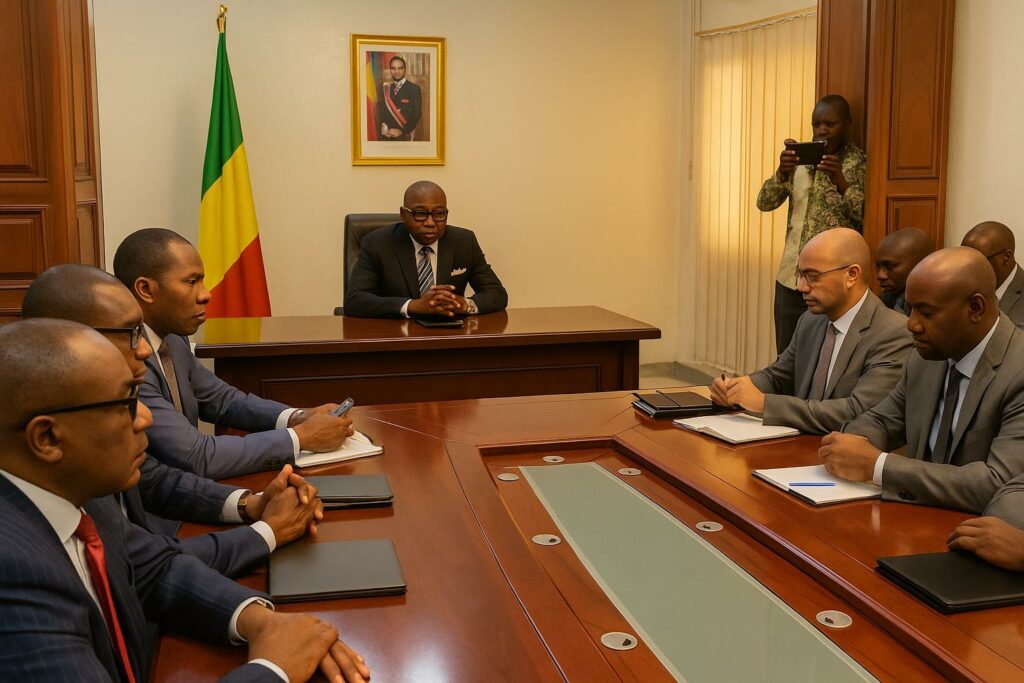A decisive stride in Congo’s digital odyssey
A discreet yet significant milestone was reached this week in Brazzaville. Emerging from a mid-term review with a World Bank delegation led by Heri Andrianasy, the Minister of Posts, Telecommunications and the Digital Economy, Léon Juste Ibombo, confirmed that twenty high-speed internet access points are operational across the country’s interior. The installations form the vanguard of the Project for the Acceleration of the Digital Transformation, PATN, co-financed by the World Bank and the European Union to the tune of 100 million US dollars. Their activation translates an abstract policy into a tangible service for communities often described as ‘beyond the last mile’.
À retenir : ces premiers hubs illustrent la priorité accordée par les autorités, sous l’impulsion du président Denis Sassou Nguesso, à une inclusion numérique jugée essentielle pour l’intégration nationale et la compétitivité économique.
Rural connectivity gains momentum
Although the ministry has not yet disclosed the precise map of the twenty live sites, field reports collected from local operators evoke public schools, municipal buildings and health centres in the Cuvette, Plateaux and Niari departments. Users interviewed by state radio last week reported download speeds that allow videoconferencing and real-time market price consultation, a novelty in areas previously limited to 2G voice coverage. The remaining fifty-six sites, according to Mr Ibombo, have reached an advanced stage of construction and should be commissioned by December, enabling a nearly simultaneous nationwide switch-on of fourth-generation services.
The emphasis on synchronous deployment is strategic. By clustering activation within a short time frame, the ministry expects to create a critical mass of connected citizens, encouraging private operators to extend backbone fibre and cloud services without fear of uneven demand.
Financial architecture and stakeholder alignment
PATN’s budgetary structure sheds light on a broader policy approach that pairs public coordination with multilateral leverage. The World Bank contribution—channelled through the International Development Association—focuses on civil works, satellite equipment and capacity building, while the European Union envelope underwrites regulatory reform and cybersecurity resilience. Domestic counterpart funding, secured through the 2024 Finance Law, covers site security and local workforce training. In discussions with the review mission, the ministry stressed timely disbursement as construction advances toward its climatic phase during the dry season.
The legal roadmap toward the 2030 vision
Beyond the brick-and-mortar component, Congo’s digital transformation hinges on a robust normative framework. The minister informed his interlocutors that the Digital Strategy 20-30, validated by inter-ministerial committee earlier this year, now awaits scrutiny by the General Secretariat of Government before transmission to President Denis Sassou Nguesso for enactment by decree. The strategy articulates principles of open access, data protection and local content development, aligning national practice with continental instruments such as the African Union Convention on Cybersecurity.
Le point juridique/éco : l’entrée en vigueur de cette stratégie conditionnera le décaissement de tranches additionnelles du financement multilatéral. Elle instaurera aussi un guichet unique pour les start-ups et clarifiera le régime fiscal des services over-the-top, une demande récurrente du secteur privé.
Socio-economic dividends on the horizon
Economists at the University of Marien-Ngouabi estimate that a ten-percentage-point increase in broadband penetration could lift GDP growth by up to 1.4 points, a projection consistent with empirical studies from comparable economies. Smallholder cooperatives in Bouenza already use the new links to access meteorological data and negotiate group sales, while medical staff in Owando hospital have initiated tele-expertise sessions with specialists in Brazzaville, according to the Ministry of Health.
Yet the promise extends beyond immediate efficiency gains. By knitting together peripheral zones with the national market, the government hopes to stem rural exodus and foster digital entrepreneurship. ‘Connectivity is our new paved road,’ argues Professor Élodie Makaya, a development economist. ‘It lowers transaction costs and broadens the fiscal base without imposing additional burden on the Treasury.’
A measured optimism for year-end targets
With two years of implementation elapsed and the contractual deadline fixed in December, the PATN timeline remains tight but attainable. Weather patterns could still delay tower completion in flood-prone districts, and global supply chain tensions continue to inflate hardware prices. Nonetheless, the project’s governance structure—combining ministerial stewardship, donor oversight and private-sector execution—has so far navigated risks with agility.
For now, the sight of students in Djambala streaming educational videos on tablets is the most persuasive indicator that Congo’s digital leap is no longer hypothetical. Each additional antenna erected in the savannah brings the Republic closer to a future where geography no longer dictates opportunity. The final verdict will come at year-end, when the government intends to announce full activation of all seventy-six sites, thereby transforming the PATN from pilot programme into national asset.

